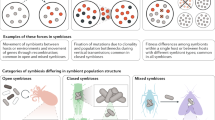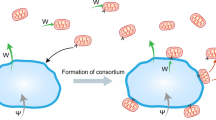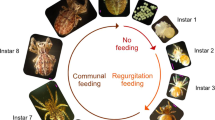Abstract
Reliable transmission of symbionts between host generations facilitates the evolution of beneficial and pathogenic associations. Although transmission mode is typically characterized as either vertical or horizontal, the prevalence of intermediate transmission modes, and their impact on symbiont genome evolution, are understudied. Here, we use population genomics to explore mixed transmission modes of chemosynthetic bacterial symbionts in the bivalve Solemya velum. Despite strong evidence for symbiont inheritance through host oocytes, whole-genome analyses revealed signatures of frequent horizontal transmission, including discordant mitochondrial-symbiont genealogies, widespread recombination and a dynamic symbiont genome structure consistent with evolutionary patterns of horizontally transmitted associations. Population-level analyses thus provide a tractable means of ascertaining the fidelity of vertical versus horizontal transmission. Our data support the strong influence horizontal transmission can have on symbiont genome evolution, and shed light on the dynamic evolutionary pressures shaping symbiotic bacterial genomes.
Similar content being viewed by others
Log in or create a free account to read this content
Gain free access to this article, as well as selected content from this journal and more on nature.com
or
References
Awadalla P, Eyre-Walker A, Smith JM . (1999). Linkage disequilibrium and recombination in hominid mitochondrial DNA. Science 286: 2524–2525.
Bairoch A, Apweiler R . (2000). The SWISS-PROT protein sequence database and its supplement TrEMBL in 2000. Nucleic Acids Res 28: 45–48.
Beller HR, Chain PSG, Letain TE, Chakicherla A, Larimer FW, Richardson PM et al. (2006). The genome sequence of the obligately chemolithoautotrophic facultatively anaerobic bacterium Thiobacillus denitrificans. J Bacteriol 188: 1473–1488.
Bernt M, Donath A, Jühling F, Externbrink F, Florentz C, Fritzsch G et al. (2013). MITOS: improved de novo metazoan mitochondrial genome annotation. Mol Phylogenet Evol 69: 313–319.
Bi D, Xu Z, Harrison EM, Tai C, Wei Y, He X et al. (2011). ICEberg: a web-based resource for integrative and conjugative elements found in bacteria. Nucleic Acids Res 40: D621–D626.
Boisvert S, Raymond F, Godzaridis É, Laviolette F, Corbeil J . (2012). Ray Meta: scalable de novo metagenome assembly and profiling. Genome Biol 13: R122.
Bolger AM, Lohse M, Usadel B . (2014). Trimmomatic: a flexible trimmer for Illumina sequence data. Bioinformatics 30: 2114–2120.
Bouckaert RR . (2010). DensiTree: making sense of sets of phylogenetic trees. Bioinformatics 26: 1372–1373.
Brandvain Y, Goodnight C, Wade MJ . (2011). Horizontal transmission rapidly erodes disequilibria between organelle and symbiont genomes. Genetics 189: 397–404.
Bright M, Bulgheresi S . (2010). A complex journey: transmission of microbial symbionts. Nat Rev Microbiol 8: 218–230.
Byler KA, Carmi-Veal M, Fine M, Goulet TL . (2013). Multiple symbiont acquisition strategies as an adaptive mechanism in the coral Stylophora pistillata. PLoS One 8: e59596.
Camacho C, Coulouris G, Avagyan V, Ma N, Papadopoulos J, Bealer K et al. (2009). BLAST+: architecture and applications. BMC Bioinformatics 10: 421.
Cary S . (1994). Vertical transmission of a chemoautotrophic symbiont in the protobranch bivalve. Solemya reidi. Mol Mar Biol Biotech 3: 121.
Cavanaugh CM, McKiness ZP, Newton I, Stewart FJ . (2013) Marine chemosynthetic symbioses. In: Rosenberg E (ed.). The Prokaryotes – Prokaryotic Biology and Symbiotic Associations. Springer-Verlag: Berlin, Heidelberg, pp 579–607.
Cerveau N, Leclercq S, Leroy E, Bouchon D, Cordaux R . (2011). Short- and long-term evolutionary dynamics of bacterial insertion sequences: insights from Wolbachia endosymbionts. Genome Biol Evol 3: 1175–1186.
Cingolani P, Platts A, Wang LL, Coon M, Nguyen T, Wang L et al. (2012). A program for annotating and predicting the effects of single nucleotide polymorphisms, SnpEff: SNPs in the genome of Drosophila melanogaster strain w1118; iso-2; iso-3. Fly (Austin) 6: 80–92.
Darling AE, Mau B, Perna NT . (2010). progressiveMauve: multiple genome alignment with gene gain, loss and rearrangement. PLoS One 5: e11147.
Decker C, Olu K, Arnaud-Haond S, Duperron S . (2013). Physical proximity may promote lateral acquisition of bacterial symbionts in vesicomyid clams. PLoS One 8: e64830.
DePristo MA, Banks E, Poplin R, Garimella KV, Maguire JR, Hartl C et al. (2011). A framework for variation discovery and genotyping using next-generation DNA sequencing data. Nat Genet 43: 491–498.
Dmytrenko O, Russell SL, Loo WT, Fontanez KM, Liao L, Roeselers G et al. (2014). The genome of the intracellular bacterium of the coastal bivalve, Solemya velum: a blueprint for thriving in and out of symbiosis. BMC Genomics 15: 924.
Ebert D . (2013). The epidemiology and evolution of symbionts with mixed-mode transmission. Annu Rev Ecol Evol Syst 44: 623–643.
Edgar RC . (2004). Muscle: multiple sequence alignment with high accuracy and high throughput. Nucleic Acids Res 32: 1797–2004.
Eldon B, Wakeley J . (2009). Coalescence times and FST under a skewed offspring distribution among individuals in a population. Genetics 181: 615–629.
Fujiwara Y, Okutani T, Yamanaka T, Kawato M . (2009). Solemya pervernicosa lives in sediment underneath submerged whale carcasses: its biological significance. Venus 68: 27–37.
Gomes D, Stefânia da Silva Batista J, Rolla AAP, Paulina Da Silva L, Bloch C, Galli-Terasawa LV, Hungria M . (2014). Proteomic analysis of free-living Bradyrhizobium diazoefficiens: highlighting potential determinants of a successful symbiosis. BMC Genomics 15: 643.
Gurevich A, Saveliev V, Vyahhi N, Tesler G . (2013). QUAST: quality assessment tool for genome assemblies. Bioinformatics 29: 1072–1075.
Gustafson RG, Lutz RA . (1992). Larval and early post-larval development of the protobranch bivalve Solemya velum (Mollusca: Bivalvia). J Mar Biol Ass UK 72: 383–402.
Halkett F, Simon J-C, Balloux F . (2005). Tackling the population genetics of clonal and partially clonal organisms. Trends Ecol Evol 20: 194–201.
Hewitt GM . (1996). Some genetic consequences of ice ages, and their role in divergence and speciation. Biol J Linnean Soc 58: 247–276.
Hill WG, Robertson A . (1968). Linkage disequilibrium in finite populations. Theor Appl Genet 38: 226–231.
Hyatt D, LoCascio PF, Hauser LJ, Uberbacher EC . (2012). Gene and translation initiation site prediction in metagenomic sequences. Bioinformatics 28: 2223–2230.
Itoh H, Aita M, Nagayama A, Meng X-Y, Kamagata Y, Navarro R et al. (2014). Evidence of environmental and vertical transmission of Burkholderia symbionts in the oriental chinch bug, Cavelerius saccharivorus (Heteroptera: Blissidae). Appl Envir Microb 80: 5974–5983.
Kaltz O, Koella JC . (2003). Host growth conditions regulate the plasticity of horizontal and vertical transmission in Holospora undulata, a bacterial parasite of the protozoan Paramecium caudatum. Evolution 57: 1535–1542.
Kearse M, Moir R, Wilson A, Stones-Havas S, Cheung M, Sturrock S et al. (2012). Geneious basic: an integrated and extendable desktop software platform for the organization and analysis of sequence data. Bioinformatics 28: 1647–1649.
Kelley DR, Schatz MC, Salzberg SL . (2010). Quake: quality-aware detection and correction of sequencing errors. Genome Biol 11: R116.
Kielbasa SM, Wan R, Sato K, Horton P, Frith MC . (2011). Adaptive seeds tame genomic sequence comparison. Genome Res 21: 487–493.
Kleiner M, Young JC, Shah M, VerBerkmoes NC, Dubilier N . (2013). Metaproteomics reveals abundant transposase expression in mutualistic endosymbionts. mBio 4: e00223-13.
Krueger DM, Gustafson RG, Cavanaugh CM . (1996). Vertical transmission of chemoautotrophic symbionts in the bivalve Solemya velum (Bivalvia: Protobranchia). Biol Bull 190: 195–202.
Krzywinski M, Schein J, Birol I, Connors J, Gascoyne R, Horsman D et al. (2009). Circos: an information aesthetic for comparative genomics. Genome Res 19: 1639–1645.
Kurtz S, Phillippy A, Delcher AL, Smoot M, Shumway M, Antonescu C et al. (2004). Versatile and open software for comparing large genomes. Genome Biol 5: R12.
Lagesen K, Hallin P, Rodland EA, Staerfeldt HH, Rognes T, Ussery DW . (2007). RNAmmer: consistent and rapid annotation of ribosomal RNA genes. Nucleic Acids Res 35: 3100–3108.
Leplae R, Lima-Mendez G, Toussaint A . (2009). ACLAME: A CLAssification of Mobile genetic Elements, update 2010. Nucleic Acids Res 38: D57–D61.
Li H, Handsaker B, Wysoker A, Fennell T, Ruan J, Homer N et al. (2009). The sequence alignment/map format and SAMtools. Bioinformatics 25: 2078–2079.
Lowe TM, Eddy SR . (1997). tRNAscan-SE: a program for improved detection of transfer RNA genes in genomic sequence. Nucleic Acids Res 25: 955–964.
Lunter G, Goodson M . (2011). Stampy: a statistical algorithm for sensitive and fast mapping of Illumina sequence reads. Genome Res 21: 936–939.
Marcais G, Kingsford C . (2011). A fast, lock-free approach for efficient parallel counting of occurrences of k-mers. Bioinformatics 27: 764–770.
Marshall IPG, Blainey PC, Spormann AM, Quake SR . (2012). A single-cell genome for Thiovulum sp. Appl Envir Microb 78: 8555–8563.
McCutcheon JP, von Dohlen CD . (2011). An interdependent metabolic patchwork in the nested symbiosis of mealybugs. Curr Biol 21: 1366–1372.
McCutcheon JP, Moran NA . (2011). Extreme genome reduction in symbiotic bacteria. Nat Rev Microbiol 10: 13–26.
Moran NA, Bennett GM . (2014). The tiniest tiny genomes. Annu Rev Microbiol 68: 195–215.
Mouton L, Thierry M, Henri H, Baudin R, Gnankine O, Reynaud B et al. (2012). Evidence of diversity and recombination in Arsenophonus symbionts of the Bemisia tabaci species complex. BMC Microbiol 12: 1–15.
Moya A, Peretó J, Gil R, Latorre A . (2008). Learning how to live together: genomic insights into prokaryote–animal symbioses. Nat Rev Genet 9: 218–229.
Nei M, Li WH . (1979). Mathematical model for studying genetic variation in terms of restriction endonucleases. Proc Natl Acad Sci 76: 5269–5273.
Newton ILG, Bordenstein SR . (2011). Correlations between bacterial ecology and mobile DNA. Curr Microbiol 62: 198–208.
Normark BB, Ross L . (2014). Genetic conflict, kin and the origins of novel genetic systems. Philos Trans R Soc B 369: 20130364.
Oliver G, Rodrigues CF, Cunha MR . (2011). Chemosymbiotic bivalves from the mud volcanoes of the Gulf of Cadiz, NE Atlantic, with descriptions of new species of Solemyidae, Lucinidae and Vesicomyidae. ZooKeys 113: 1–38.
Paradis E, Claude J, Strimmer K . (2004). APE: analyses of phylogenetics and evolution in R language. Bioinformatics 20: 289–290.
Parks DH, Imelfort M, Skennerton CT, Hugenholtz P, Tyson GW . (2014). Assessing the quality of microbial genomes recovered from isolates, single cells, and metagenomes. Genome Res 25: 1043–1055.
Peng Y, Leung HCM, Yiu SM, Chin FYL . (2012). IDBA-UD: a de novo assembler for single-cell and metagenomic sequencing data with highly uneven depth. Bioinformatics 28: 1420–1428.
Phipson B, Smyth GK . (2010). Permutation P-values should never be zero: calculating exact P-values when permutations are randomly drawn. Stat Appl Genet Mol Biol 9: 39.
Plazzi F, Ribani A, Passamonti M . (2013). The complete mitochondrial genome of Solemya velum (Mollusca: Bivalvia) and its relationships with Conchifera. BMC Genomics 14: 409.
Quinlan AR, Hall IM . (2010). BEDTools: a flexible suite of utilities for comparing genomic features. Bioinformatics 26: 841–842.
R Core Development Team. (2012) R: A Language and Environment for Statistical Computing. The R Foundation for Statistical Computing: Vienna, Austria.
Rissman AI, Mau B, Biehl BS, Darling AE, Glasner JD, Perna NT . (2009). Reordering contigs of draft genomes using the Mauve Aligner. Bioinformatics 25: 2071–2073.
Ronquist F, Teslenko M, van der Mark P, Ayres DL, Darling A, Höhna S et al. (2012). MrBayes 3.2: efficient Bayesian phylogenetic inference and model choice across a large model space. Syst Biol 61: 539–542.
Ros VID, Fleming VM, Feil EJ, Breeuwer JAJ . (2012). Diversity and recombination in Wolbachia and Cardinium from Bryobia spider mites. BMC Microbiol 12: S13.
Russell SL Mode and fidelity of bacterial symbiont transmission and its impact on symbiont genome evolution. PhD thesis. Harvard University, Cambridge, MA, pp 123–139.
Salem H, Florez L, Gerardo N, Kaltenpoth M . (2015). A out-of-body experience: the extracellular dimension for the transmission of mutualistic bacteria in insects. Proc R Soc B 282: 20142957.
Schmitt S, Angermeier H, Schiller R, Lindquist N, Hentschel U . (2008). Molecular microbial diversity survey of sponge reproductive stages and mechanistic insights into vertical transmission of microbial symbionts. Appl Envir Microbiol 74: 7694–7708.
Sharma PP, Zardus JD, Boyle EE, González VL, Jennings RM, McIntyre E et al. (2013). Into the deep: a phylogenetic approach to the bivalve subclass Protobranchia. Mol Phylogenet Evol 69: 188–204.
Siguier P, Filée J, Chandler M . (2006). Insertion sequences in prokaryotic genomes. Curr Opin Microb 9: 526–531.
Sipkema D, de Caralt S, Morillo JA, Al-Soud WA, Sørensen SJ, Smidt H et al. (2015). Similar sponge-associated bacteria can be acquired via both vertical and horizontal transmission. Environ Microbiol 17: 3807–3821.
Stamatakis A . (2014). RAxML version 8: a tool for phylogenetic analysis and post-analysis of large phylogenies. Bioinformatics 30: 1312–1313.
Stewart FJ, Cavanaugh CM . (2006). Bacterial endosymbioses in Solemya (Mollusca: Bivalvia)—model systems for studies of symbiont–host adaptation. Antonie van Leeuwenhoek 90: 343–360.
Stewart FJ, Dmytrenko O, Delong EF, Cavanaugh CM . (2011). Metatranscriptomic analysis of sulfur oxidation genes in the endosymbiont of Solemya velum. Front Microbiol 2: 134.
Stewart FJ, Young CR, Cavanaugh CM . (2008). Lateral symbiont acquisition in a maternally transmitted chemosynthetic clam endosymbiosis. Mol Biol Evol 25: 673–687.
Suzek BE, Huang H, McGarvey P, Mazumder R, Wu CH . (2007). UniRef: comprehensive and non-redundant UniProt reference clusters. Bioinformatics 23: 1282–1288.
Taylor JD, Glover EA, Williams ST . (2008). Ancient chemosynthetic bivalves: systematics of Solemyidae from eastern and southern Australia (Mollusca: Bivalvia). Mem Queensl Mus 54: 75–104.
Van der Auwera GA, Carneiro MO, Hartl C, Poplin R, del Angel G, Levy-Moonshine A et al. (2002) From FastQ Data to High-Confidence Variant Calls: The Genome Analysis Toolkit Best Practices Pipeline. John Wiley and Sons, Inc.: Hoboken, NJ, USA.
Vos M, Didelot X . (2008). A comparison of homologous recombination rates in bacteria and archaea. ISME J 3: 199–208.
Wu M, Eisen JA . (2008). A simple, fast, and accurate method of phylogenomic inference. Genome Biol 9: R151.
Zheng X, Levine D, Shen J, Gogarten SM, Laurie C, Weir BS . (2012). A high-performance computing toolset for relatedness and principal component analysis of SNP data. Bioinformatics 28: 3326–3328.
Zhou Y, Liang Y, Lynch KH, Dennis JJ, Wishart DS . (2011). PHAST: a fast phage search tool. Nucleic Acids Res 39: W347–W352.
Zimin AV, Marçais G, Puiu D, Roberts M, Salzberg SL, Yorke JA . (2013). The MaSuRCA genome assembler. Bioinformatics 29: 2669–2677.
Acknowledgements
We thank Frank Stewart, Gonzalo Giribet, Peter Girguis, Cassandra Extavour, members of the Cavanaugh Lab, and three anonymous reviewers for valuable suggestions and comments. We gratefully acknowledge support from Harvard University’s William F. Milton Fund, Department of Organismic and Evolutionary Biology, and Microbial Sciences Initiative. Jonathan Finlay provided valuable help with collection of the S. velum population samples. We thank Harvard’s Museum of Comparative Zoology for the S. velesiana specimen (BivAToL project) and the S. elarraichensis specimen (collected by Marina R Cunha supported by project HERMES (contract GOCE-CT-2005-511234) and project HERMIONE (contract 226354) and donated to the BivAToL project). This work was supported from Harvard University’s William F. Milton Fund, Department of Organismic and Evolutionary Biology, and Microbial Sciences Initiative.
Author information
Authors and Affiliations
Corresponding authors
Ethics declarations
Competing interests
The authors declare no conflict of interest.
Additional information
Supplementary Information accompanies this paper on The ISME Journal website
Supplementary information
Rights and permissions
About this article
Cite this article
Russell, S., Corbett-Detig, R. & Cavanaugh, C. Mixed transmission modes and dynamic genome evolution in an obligate animal–bacterial symbiosis. ISME J 11, 1359–1371 (2017). https://doi.org/10.1038/ismej.2017.10
Received:
Revised:
Accepted:
Published:
Issue date:
DOI: https://doi.org/10.1038/ismej.2017.10
This article is cited by
-
Fidelity varies in the symbiosis between a gutless marine worm and its microbial consortium
Microbiome (2022)
-
Endosymbiont population genomics sheds light on transmission mode, partner specificity, and stability of the scaly-foot snail holobiont
The ISME Journal (2022)
-
Genetic innovations in animal–microbe symbioses
Nature Reviews Genetics (2022)
-
Bacterial communities associated with hydromedusa Gonionemus vertens in different regions in Chinese coastal waters
Journal of Oceanology and Limnology (2022)
-
Functional diversity enables multiple symbiont strains to coexist in deep-sea mussels
Nature Microbiology (2019)



